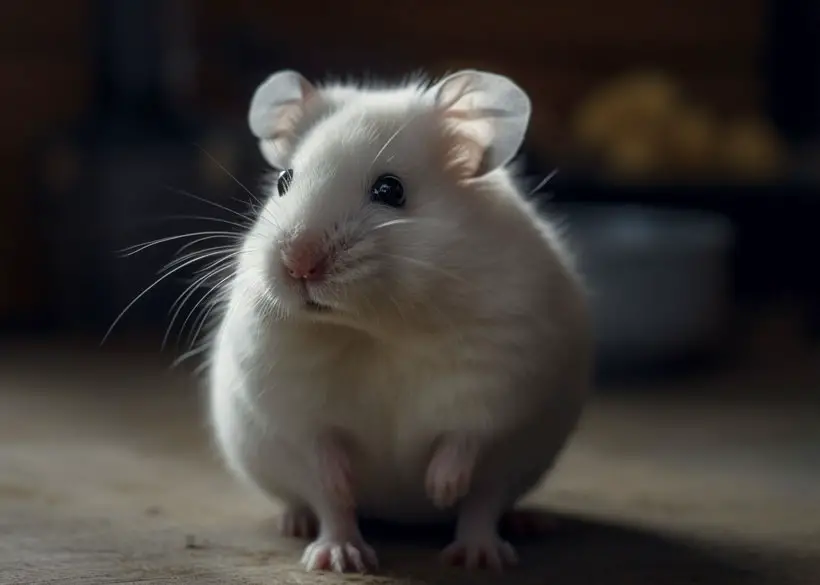What Does Hamster Pee Look Like? Things You Should Look Out For
Welcome to the curious world of hamster hygiene! As cute and cuddly as these furry pets can be, they also produce waste that can tell us a lot about their health and well-being.
So what does hamster pee look like? Hamster urine is usually pale yellow to amber in color and has a strong, pungent odor. Normal hamster urine should be clear and free-flowing, no matter the color. But changes in color, consistency, or odor may indicate a potential health issue.
In this article, we’ll explore the appearance, color, and consistency of hamster urine, as well as what it might mean if it changes. So, grab a cup of coffee, and let’s dive into the wonderful world of hamster health!
What Does Hamster Pee Look Like?
Generally, hamster urine is milky-white. However, it can range from a pale yellow to deep amber. And this depends on the concentration of waste products and the amount of hydration in their bodies.
Moreover, normal hamster urine should be a little cloudy but free of any noticeable particles or sediment. However, it’s not uncommon to see small crystals in the urine of dehydrated hamsters. In some cases, you might also see a small amount of mucus in the urine, which is usually harmless.

The consistency of hamster urine can vary, but it is usually quite thicker than that of any human. This is because, in nature, the hamsters are found in a more arid environment that is scarce of water and moist. Thus their body tries to reduce dehydration by producing more concentrated urine.
The cloudiness is also due to the protein and crystals within the urine. Moreover, the protein excretion rate from hamsters’ urine is close to 10 mg per week, which is nearly ten times that of humans.
Different Hamster Pee Color And Cause
Hamster urine is an important indicator of their overall health and well-being. It’s fascinating to know that these tiny creatures produce waste that can reveal so much about their health status.

A table on hamster pee colors and possible reasons is provided below.
| Pee Color | Possible Cause | Should You Be Worried? |
|---|---|---|
| Red/Clowdy | Urinary tract infection | Medical attention is urgent |
| Brown/Dark | Liver problems, can be diarrhea | If the problem persists, go to a vet |
| Yellow | Can be due to a changed diet | No need to worry |
Factors Affecting Hamster Pee Appearance
There are several factors that can affect the appearance of hamster urine, They are;

Hydration
Hamsters that are dehydrated will produce concentrated urine that is darker in color. Adequate hydration will produce lighter, clearer urine.
Diet
Hamsters that eat a high-protein diet will produce urine that is more yellow in color, while those that eat a high-carbohydrate diet will produce urine that is clearer.
Age
As hamsters age, their kidneys may become less efficient, producing darker, more concentrated urine.

Disease
Certain diseases, such as urinary tract infections or kidney disease, can cause changes in the appearance of hamster urine. This can include the presence of blood or an unusual odor.
Medications
Certain medications, such as antibiotics, can affect the appearance of hamster urine.
It’s important to keep an eye on your hamster’s urine appearance and consult with a veterinarian if you notice any changes or abnormalities.
Common Changes in Hamster Pee Appearance
Hamster urine can vary in appearance and color, which can be caused by various factors such as diet, hydration, and health conditions. Here are some common changes in hamster urine appearance:

Clear or Transparent
This is a sign of good hydration and a healthy urinary tract.
Yellow
Normal, healthy hamster urine is typically yellow. However, if the urine appears extremely yellow, it may indicate dehydration.
Orange
This color can indicate that the hamster is dehydrated or that it has high levels of pigments in its diet, such as beta-carotene found in carrots.
Red or Pink
This can be a sign of blood in the urine, which is a serious health concern and requires veterinary attention.
Cloudy
Cloudy urine can indicate a urinary tract infection, which requires veterinary attention.
Dark
Dark or brownish urine can indicate liver problems or the presence of high levels of metabolic waste products.
How to Monitor Your Hamster’s Pee

To monitor your hamster’s pee, you can follow these actions:
Observe the cage
Look for any noticeable changes in the amount or appearance of your hamster’s urine.
Check the bedding
If the bedding appears damp or has a strong odor, it may indicate a change in your hamster’s urination habits.
Keep track of changes
Take note of any changes in the amount or frequency of your hamster’s urination and any accompanying symptoms, such as lethargy or discomfort.
Consult a vet
If you notice any concerning changes in your hamster’s urination, it’s best to consult a veterinarian for a proper diagnosis and treatment plan.
It’s important to monitor your hamster’s urination habits, as changes can be an indicator of a health problem. By being vigilant and seeking veterinary care when necessary, you can help keep your hamster healthy and happy.
How to Keep Your Hamster’s Pee Normal
Maintaining normal urine production and elimination in hamsters requires attention to their diet, water intake, and cage hygiene. Here are some steps you can follow:

Step 1: Provide fresh water
Ensure your hamster has access to clean, fresh water at all times. A water bottle is recommended instead of a bowl as it prevents contamination.
Step 2: Offer a balanced diet
Hamsters require a balanced diet of high-quality pellets, fresh vegetables and occasional fruit, and occasional treats. An unbalanced diet can lead to urinary issues.
Step 3: Maintain cage hygiene
Clean the cage regularly and spot clean daily. The cage should be large enough for the hamster to exercise, and the bedding should be changed frequently to prevent urine and feces buildup.
Step 4: Watch for signs of illness
If you notice any changes in your hamster’s behavior or urination habits, take it to a veterinarian for a check-up as soon as possible. Some illnesses, such as a urinary tract infection, can cause changes in urination.
Step 5: Provide a dust bath
Hamsters clean themselves by rolling in the dust, which helps them maintain healthy skin and fur. You can provide a dust bath for your hamster to help keep its urinary tract healthy.
Remember, maintaining a healthy environment and diet for your hamster is the best way to ensure normal urine production and elimination. If you have any concerns, consult a veterinarian for advice.
Understanding your hamster’s behavior can be crucial in monitoring their health. If you notice your hamster lying flat on its stomach, it might be a cause for concern. Our article on why hamsters lie flat on their stomach can help you understand the possible reasons behind this behavior. Additionally, it’s important to know what type of hamster you have so you can provide the best care possible. Our article on what kind of hamster do I have can assist you in identifying your furry friend. And if you’re looking for more information on hamster health and care, be sure to check out our other articles on RodentsFact.com.Frequently Asked Questions
In this section, we’ll discuss some of the common factors you may still have regarding hamster pee.
Q: How Can I Tell If My Hamster Is Drinking Enough Water?
You can check if your hamster is drinking enough water by observing the frequency and amount of urination. Adequate hydration is important for the overall health of your hamster.
Q: How Often Should I Expect My Hamster To Urinate?
Hamsters typically urinate several times a day.
Q: Is It Normal For Hamster Urine To Have A Strong Odor?
Yes, hamster urine has a distinct, strong odor.
Q: Can Stress Affect The Appearance Of Hamster Urine?
Yes, stress can cause changes in the amount and appearance of hamster urine.
Conclusion
Hamsters are such amazing companions, and we must take extra care of this unique animal. So now you know what does hamster pee look like. Depending on the hamster’s activity and habits, it can seem like drops, a puddle, or another combination of both.
Regardless of how it appears, it’s crucial to keep an eye on your hamster’s pee production since variations in color, smell, or frequency might point to medical issues. In order to make sure your pet hamster is healthy and content, remember to examine and keep an eye on their urine.




